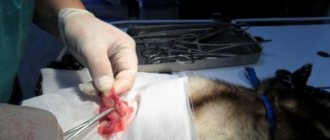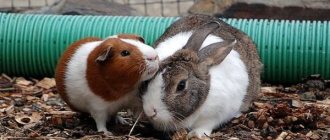From time to time, when I walk with my ferret in a specialized park, I hear a conversation between two breeders who are actively discussing one question: “ Who is better, a male or a female ferret?” ". Debates can sometimes last several tens of minutes, but they still fail to come to a logical conclusion, as they say, “every sandpiper praises his swamp.” Perhaps they just like to talk about this topic, and they are having fun, without any intentions of offending each other, especially since I often see them together, apparently old friends. Of course, it’s stupid to argue which of them is better, a female or a male ferret, but there are still some visual differences in behavior and character.
Determining the sex of a ferret
Sexual demorphism in ferrets is pronounced. Males are larger, sometimes almost twice as large, and stockier. They have a flat muzzle and thick, strong paws. In order to distinguish young animals by gender when purchasing, you need to turn the animal over on its back and carefully examine the abdomen. Males have a tubercle quite far from the tail. Females have only an anus under their tail.
It is, of course, easier to determine sex when the animal has reached adulthood. Males weigh up to 2.5 kg, females up to 1 kg. Males eat a lot, mark their territory with urine and feces, and smell strongly. For these reasons, breeders strongly advise that ferrets be neutered between 10 and 12 months of age.
Sexually mature females are slender and graceful. Their muzzle is longer, and their limbs are thinner and slightly longer. Girls eat less and often hide food in reserve, setting up a hiding place in the corner of a cage or apartment. They are more cautious and less amenable to taming.
Ferret at home: choosing sex, pros and cons
- home
- Communities
- Life according to interests
- My beast
April 28, 2011 10:57 pm
*Before bringing a ferret into your home, you must choose the sex of the animal. Male and female ferrets differ greatly.
Females are more trainable and more obedient than males, so it is much easier to train them to use a tray. The behavior of females is more varied and is mainly aimed at exploring the territory. Females are more independent, less attached to humans and more attached to the territory in which they live, but at the same time, they are more trainable and more understanding than males. They are more playful, active and restless. They easily tolerate changes in owner and environment. On average, females are smarter and more intelligent than males. Generally speaking, females are more interested in the world around them than the owner, and males - vice versa. Females are safer for children. If a person does not have experience keeping ferrets, he is often recommended to get a female. The main problem that faces the owner of a female is the need to either get offspring from her or sterilize her. This is due to the fact that female ferrets cannot come out of heat on their own.
The male ferret is an animal that has “something to grab onto.” With good hereditary conditions and proper care, this is a luxurious animal, with magnificent fur and a beautiful face. However, a male is more difficult to litter train than a female, and during adolescence he will try to dominate his owner (as do maturing dog puppies). Males are lazier and calmer, attached to their owner, they have a stronger nervous system, many like to sleep in their arms. However, during the rut, uncastrated males become very active and restless, mark their territory, lose their appetite, respond worse to commands and are constantly looking for a female. In raising a male, one must show more perseverance and firmness than in the case of a female, and devote more time to communicating with the animal. Males also need to be neutered, unless you want to participate in ferret breeding. The fact is that during the rut, males begin to mark the territory with urine marks, which have a strong unpleasant odor. In addition, males become more aggressive and disobedient. The most optimal age for castration is 6-8 months. Sexual maturity in ferrets can occur at 5-7 months. Male ferrets are capable of fruitful mating for up to 5 years. Females, as a rule, successfully reproduce annually for 3-4 years. The ferrets' rut lasts from March to September. The female needs to be mated (covered) approximately two weeks after the start of estrus. At the beginning of estrus, the female especially needs vitamins! It is necessary to add calcium, phosphorus, vitamins D, A, B, and yeast to the feed. When choosing a pair, you should stick to the same color from both manufacturers. Introducing ferrets should take place on the male's territory. Mating in ferrets is a stormy and noisy process, accompanied by squealing, screaming and fighting.
Pregnancy in ferrets lasts 40-45 days. A pregnant female eats, drinks, sleeps more, sheds actively and tries to be careful in her movements. A pregnant female ferret is fed twice as much as usual. A double dose of vitamins should be added to the food.
There are both “pros” and “cons” in keeping a ferret.
Pros:
A cheerful and affectionate animal, adapts to the regime of its owners, ferrets go to the litter box like cats, small and light, easy to carry with you, never gets bored, loyal like a dog, plays like a puppy until old age, calmly walks in a harness, many people like it the musky smell of a ferret, bordering on honey, they know their owner, ferret fur is less likely to cause allergies than cat fur, very smart animals, ferrets are warmer than cats, in winter it is impossible to freeze when walking with a ferret by the scruff of the neck, gets along well with other domestic animals, independent
Minuses:
It is necessary to pay more attention than to a cat, some people do not like the musky smell of a ferret, when a ferret is very frightened, it uses stink glands (prianal glands), the curiosity and playfulness of ferrets can lead to injuries, they love to dig flowers, males mark their territory during the rut - like cats , female polecats cannot come out of heat on their own, they drag things and food into burrows, polecats cannot be fed food from the table, there are few experts on polecats, they may not get along with a hunting dog (for example, a dachshund), some chores are not so responsible when it comes to the bathroom , like cats, ferrets and small children are easily excitable, the combination of both can be unpredictable, love to chew elastic, springy materials, have a passion for garbage cans, which they tear.
What gender should I get a ferret?
Male and female ferrets differ greatly in size, proportions, as well as character and behavior.
Males are one and a half to two times larger and heavier than females. The average weight of a male is 1.5-2 kg, although there are animals weighing up to 3 kg. The muzzle of males is wider and flatter than that of females, and the fur is thicker. A well-groomed large male in winter fur looks like a miniature bear.
Compared to males, females look much more elegant and graceful. They are sharper-faced, more flexible and agile. The average weight of females is from 800 g to 1 kg.
An interesting pattern has been noticed: as a rule, males are most often attracted to females, while females, on the contrary, are attracted to males.
Male and female ferrets have different personalities, behaviors, and habits. Females are more agile, they are more dynamic and curious than males. A female can rarely sit in one place for more than 3-4 seconds: constant exploration of the territory takes up a huge part of the time in her life. Therefore, the behavior of females is more varied and interesting.
This character of females results in the fact that, compared to males, they are more independent and “on their own.” They are less attached to humans and more attached to their territory. Due to the fact that in nature females raise puppies without the help of males, females are characterized by a more flexible and developed intelligence. They are more intelligent, more trainable and much more cunning than males.
Males, on the contrary, are calmer, become more attached to their owner, and many of them are not averse to being held in their arms. The average male is inferior in intelligence to a female, but this does not mean that he is stupid. It's just that males' minds work a little differently.
Generally speaking, females are more interested in the world around them than the owner, and males - vice versa.
All of the above are just general character traits that may not be inherent in a particular animal. There are females who are very attached to the owner and constantly follow on his heels, and males who are more interested in the world around them than in humans.
Whom to choose? Who is easier to keep: a male or a female? There is no clear answer to this question. Each gender has its own advantages and disadvantages, knowing which, you can decide for yourself which one is right for you.
Females are more trainable and more obedient than males, so it is much easier to train them to use a tray. Females are safer for children. If a person does not have experience keeping ferrets, he is often recommended to get a female.
How to make friends with ferrets?
How to make two ferrets friends in 7 steps?
- Step 1. Select a friend.
If possible, get two small (or young) ferrets at once - they are guaranteed to become friends! A good option is to bring two adult ferrets of approximately the same age into your home.
If you already have an adult ferret, it is better to bring a “youngster” into your home rather than an adult pet with already established habits. The second scenario is also possible, but building a friendship will most likely take longer.
Pets of the same age and with a similar temperament will make friends the fastest. Before purchasing a second ferret, observe it and evaluate its habits.
- Step 2. We delimit the territory.
Your main task is to avoid situations where the ferrets have to share something among themselves. The cause of the dispute can be food, a bed, a hammock, a toy, or even you. At first, each pet should have its own “personal belongings”. A new ferret must have his own corner in the house, where the “old-timer” will not enter with his laws. And all the property of the “old-timer” should remain in his power: the “new guy” should not encroach on it.
In a ferret crowd, there is no clear leader, like dogs, for example, and they do not consider humans to be the undisputed leader. This makes it very easy for ferrets to communicate with their own kind and with other pets.
It will be better if the ferrets live in separate cages for the first time. Gradually, you will be able to place them closer to each other so that the pets get used to the neighborhood from a safe distance. An alternative to two cages is a spacious enclosure with dividing walls. It is important to “seat” the ferrets in their own territories and avoid head-to-head contact.
When things are sorted out, we take on ourselves. Now you have two ferrets to pay attention to, and neither of them should feel left out. Don’t get a pet – sensitive ferrets consider this a win-win situation.
- Step 3. Don't force things.
There is no need to drag two stubborn ferrets towards each other. Or forcefully hold the “new guy” who can barely breathe from fear while the old-timer sniffs him. Believe me, both of your pets are already experiencing a lot of stress. Try not to amplify it.
Give ferrets as much time as they need. Let the newcomer calmly adapt, and the old-timer gradually get used to the new smells and surroundings.
Let ferrets develop their own language. Let them sniff each other, snort, fidget, and finally lick each other. You should not interfere in ferrets’ communication before a squabble begins.
- Step 4. Play in an open space.
The path to ferret friendship lies through games. These pets are so active that even in a stressful situation they are unlikely to refuse an interesting activity. Release the ferrets from the cage. Get some new toys (that neither of your ferrets have seen yet) and engage them in play. Observe carefully how ferrets interact with each other. Stop aggression. Work as an animator until the ferrets learn to play with each other on their own.
- Step 5. Stop aggression.
If, upon first meeting, one ferret tries to bite the other, this is normal. But if your ferret shows aggression for several days and persistently tries to bite his potential friend, it's time to start training. When the ferret starts a squabble, confidently (but gently) shake him by the scruff of the neck and command “No!” and lock him in a cage. And then defiantly continue to have fun playing with your second pet.
Usually this method works. But if after 2-3 weeks there are no results, the ferret may not need any friends. This happens sometimes. In such a situation, it is better to think about keeping ferrets separately on an ongoing basis.
- Step 6. We carry it on our arms.
Everyone loves affection. And such contact pets as ferrets, even more so. When both tomboys are more or less accustomed to each other, try to pick them up, both of them at once. Talk to them kindly and treat them with treats. Happened? Nice, isn't it?
- Step 7: Make sure everyone is full.
Friendship is only valuable on a full stomach. If one of the ferrets is hungry, then he will regard the second pet as a rival in the struggle for vital resources. Watch your pets' diet. At first, it is better to feed them the same food from two different bowls and away from each other. Any treats should also be shared equally.
Is that all, you ask? From the main point, yes. You are lucky, because ferrets are very curious and sociable pets. Nature itself will push them to become friends. Ferrets do not suffer from leadership habits and love company very much. Usually, at first, strangers snort sternly at each other, but after a couple of weeks they bask together in a hammock.
Much less often, ferrets never find an approach to each other. They may not be the same in temperament or other characteristics that we can only guess about. In this case, we recommend that you talk to an animal psychologist: perhaps he can help solve the problem. And if not, there is always the option of separate contents - that’s not bad either!
We wish your ferrets the strongest friendship, and we wish you not to go crazy with emotion! It's difficult, we know.
Buying a ferret - girl or boy
When you come to an online pet supply store to buy a ferret, you, of course, rely on your heart, that is, which one looks at you and whose eyes you like best, take it. I want to tell you about the differences in behavior between female and male ferrets. Girls - they have an iron, one might say slightly nasty character. A female ferret will never allow you to dominate her. When buying any animal, not just a ferret, you will have to immediately set the record straight and explain to the animal that you are the boss of the house. It will be difficult for you to find a common language with a female; you are unlikely to convince her that she is not the mistress of the house. She is less tame than the boy. Try to squeeze it more and more at once to make it at least a little more manual. It’s not a fact that you will succeed, but you can try. The girl's insidious character is often combined with her kindness in games; she will never bite you very hard, and will always be affectionate with children and other animals. A girl is correctly and outwardly different from a boy, her face is prettier. The female ferret is left to her own devices, she is not bored alone and can run around for hours and look for something, eventually falling asleep in splendid isolation. A man is a man, you will immediately see a male ferret from the crowd, he has a serious expression on his muzzle and is usually larger. True, the size of the animal depends on the age at which you castrated it.
Male ferrets are more attached to their owner. They get used to hands more often than girls, can sleep for hours on their owner’s lap, are more affectionate, and can even accept ferret food from human hands. As for aggression, the boy will not allow himself to be offended. When communicating with strangers, the bite can be very painful.
To summarize, it is still easier to raise a boy than a girl, but girls are usually prettier and nicer, and the choice is yours.
Source
Boy
The male ferret's muzzle is slightly flattened, his appearance is serious and brutal, and his size is impressive. It seems that if you approach him and extend your hand, he will definitely bite it.
In reality, this is not the case. Males have a balanced character, are friendly and flexible, they love human hands and communication with their owner. They cannot be alone for a long time, so whenever they are bored, they will remind you of themselves by biting them on the heel (mine did exactly that).
Males love when their owner plays with them; they like to sleep on their laps or chest. But, as befits any male, he will try to get the better of you, in a word, dominate, so you will have to show who’s boss. Everything that you forbid him will only provoke and anger him.
In addition, boys are larger in size. They have thicker and softer fur, and in winter they generally look like clumsy teddy bears. Males eat more, which is what men are supposed to eat, so adult ferrets take on a well-fed appearance and do not care about their figure.
Some novice breeders prefer to take a male only because he supposedly does not have to undergo castration, which is fundamentally wrong. Yes, a male ferret can survive the rutting period, but without castration, the animal will receive significant psychological trauma. He will rape anything that in his mind can replace a female.
In addition, the male will constantly mark all corners of your apartment with urine and sometimes fecal marks throughout the entire rutting period. The smell, both from him and in the apartment, will be terrible. Do you need it? Therefore, if you do not consider your male as a sire, then castration is mandatory.
Ferret
The ferret is a member of the weasel family. There are 3 types of animals in nature: forest, steppe and American. Domestic ferrets are placed in a separate group, ferrets.
Individuals of this group are domesticated animals of forest and steppe species. Breeders have developed many varieties of ferrets, which differ in the shade of their fur.
Is it possible to keep animals in an apartment? How to care for a ferret at home?
Advantages and disadvantages
Exotic lovers keep ferrets as pets in an apartment or in a private house. The animals are unusual, have decorative colored fur, and look very pretty.
According to the description of experts, the size of the ferrets is 40 cm. They weigh 1.5-2 kg. You can get a large male or female that does not grow more than 30 cm. To breed ferrets, they buy a boy and a girl.
These are predators. In nature, they feed on small rodents. They are active at night, but domestic ferrets can also be active during the day.
In addition to natural colors, breeders offer sable, silver, and chocolate-colored animals. You can buy Dalmatians, white, black individuals.
Individuals of the champagne, blaze, and cinnamon color look unusual. How do ferrets behave at home? What pros and cons do animalists note on forums?
Place to live
A ferret at home can live on average 10 years. Individuals that live up to 15 years are considered long-livers. It is necessary to prepare a place for the animal where it will live.
It could be a cage, a house, an aviary, a display case. The home should be spacious and made of safe material:
Enclosures and display cases are best suited for animals. In a ferret's apartment, a wardrobe is often remodeled, in which several floors are arranged.
A pet needs fresh air, so ventilation must be provided in the display case.
The place for the ferret is equipped with a house where the animal rests. The animal loves to sleep in a hammock. For games, they install a running wheel, shelves, labyrinths, and objects that imitate holes.
The pet is toilet trained. To do this, install a tray with cat litter.
Caring for a ferret at home requires some physical effort. The cage must be cleaned once a week. The toilet is changed daily.
Keeping a ferret at home involves walking in the fresh air. A harness and a long leash are used for the animal.
These devices are necessary to control the activity of the animal. The animal must be accustomed to the street and to wearing a harness. Otherwise he will experience stress.
Animals
13.10 13:31
Keeping pets, fauna, flora
Hi all! Who has ferrets? Tell me, is the smell strong? Who is better to take, a boy or a girl? and how do they get along with children?
To continue the topic, if you take care of your ferret’s hygiene, the smell is not strong. We have an adult ferret, he is not neutered and his glands have not been removed. runs freely around the apartment, does not chew anything, goes to the tray or on the newspaper, bites only when he gets very angry. It's better to take a rabbit. they smell less. If you have a ferret, then the apartment should be large so that he is not in the same room with you. In males, the glands are removed and they smell less. Well, I don’t know, I have a girl, she also goes to the litter box, and if it stinks, it’s the litter box itself, if it’s not cleaned for several days. You can remove the glands with it, but there’s no need for that, it’s enough to clean them once a year. And about behavior -she loves me, listens, but somehow ignores my husband :-) and when guests come, I noticed that she somehow goes to talk to the girls more (probably because the girls immediately start cooing with her, and ferrets love affection) I don’t know about children, I also have an adult dog living at home - everything is fine with them :-) sometimes they eat from the same bowl :-) the ferret’s attitude towards others needs to be educated, if you don’t have enough patience, then he will be aggressive and bite everyone :-) I have a girl. in the tray like a cat, obedient, smart. Hates children!!!! If you have a child, it’s better not to have a child, will he constantly bite, what does it really mean to bite? strongly? How are things going with the smell? Do some glands need to be removed? Nothing was deleted, when she gets really excited she can highlight them a little and that’s it. her husband suffers a lot from her, she either hangs on his nose or grabs his eyebrow. And when the children are at home, they all gather in one cage for her. And indoor flowers are not desirable, ours is constantly digging for something, we had a boy. the smell permeated the entire apartment. My husband started having an allergy - I had to give it away... then the smell lingered for a long time where the ferret liked to sit and lie (sofa, armchairs)
(Added after 1 minute)
and bit the child’s legs and snatched the sausage out of his hands
Question for animal rights activists.
According to current legislation, stray animals are removed from the streets for veterinary preventive measures - castration, sterilization, vaccination and microchipping. After this they are released into their habitat.
Question: After these procedures, do dogs become civilized, allow women to enter buildings, accompany children to school so that cats don’t bite them, stop forming packs and pick up their excrement in a plastic bag?
What is the point of releasing... (read more)
Well, well... What about our immunity? Are we strengthening it? Before the winter cold...
Let's look at the birds: balanced nutrition in the fresh air and voila! - wonderful result - they flutter easily and gracefully!
https://photos.sakhalin.name/photo/774666
https://photos.sakhalin.name/photo/774667… (read more)
Good luck and positivity to everyone!))) Recently, the Sakhkom has been publishing news about cruelty to animals, thereby causing not only tears and pity among Formers, but also fierce disputes and clashes between two camps - “zooschiks” and “anti-zooschisics”.
The term zooschiza has become firmly entrenched in our Great and Mighty Russian language, and people who have anything to do with animals fall under it: if you fed a stray cat or dog on the street - zooschiz, a person opened a shelter - zooschiza, you just love... (read more)
Little puppy 5 months old Cane Corso is looking for friends
Continuation of the topic https://forum.sakh.com/1422189/
Good afternoon. Can anyone help with transporting a puppy from Moscow to Yuzhno-Sakhalinsk?
What to feed?
Ferrets are not picky about food. At home, they will eat everything that is offered to them, but the quality of the food must be monitored. Special food has been created for exotic animals.
It is nutritionally balanced. A vitamin and mineral complex has been added to it.
Some animalists prefer to prepare their pet’s diet themselves:
Water must be freely available. The drinking bowl is washed daily with soda. The water is changed. For drinking, use filtered water at room temperature.
Health
When keeping a pet ferret, you need to collect a first aid kit. In addition to antiseptics and dressings, it is recommended to include Vaseline.
It is fed to the animal along with food for constipation or vomiting. The kit should include first aid medications:
Diseases in domestic ferrets are often associated with improper feeding. Experts do not recommend treating animals yourself. It is necessary to contact doctors.
Keeping a ferret is difficult, but any pet requires care. You can get a lot of positive emotions from a ferret.
Source










